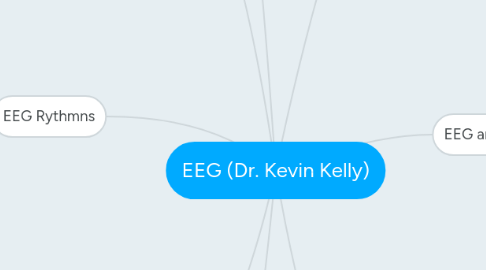
1. EEG Intro
1.1. Electroencephalography
1.2. Non invasive
1.3. Painless
1.4. Microvolt range
1.5. Hans Berger, 1924
1.5.1. First studied EEG
1.5.2. Attempted to study psychic phenomenon
1.5.3. studied brain waves of 15 years old son, Klaus
2. Tools
2.1. Electrodes (Ag-AGCL electrodes
2.1.1. Scalp electrodes (reduce impedence)
2.1.1.1. Neurons
2.1.1.1.1. Action Potential
2.1.1.1.2. Postsynaptic potential
2.1.1.2. Glid cells
2.1.1.2.1. Minimal, some DC steady potential
2.2. Electrolyte
2.2.1. Elefin
2.2.2. FC-2-paste
2.3. Preparation
2.3.1. Map out where to place electrodes on patient
2.3.2. 10-20 system
2.3.2.1. frontal
2.3.2.2. temporal
2.3.2.3. central
2.3.2.4. parietal
2.3.2.5. occipital
3. Method
3.1. Measure volt difference
3.1.1. Polygraph
3.1.1.1. Use ink pen to automatically write on paper
3.1.1.1.1. Smudging
3.1.2. Digital EEG
3.1.2.1. Digitally record the readings
3.1.2.1.1. Can store for record and read easily
4. EEG Rythmns
4.1. Higher freq
4.1.1. Active, alert, desynchronized
4.2. Gamma
4.2.1. 20-60Hz
4.2.2. Cognitive
4.3. Beta
4.3.1. 14-20Hz
4.3.2. activate cortex
4.4. Alpha
4.4.1. 8-13 Hz
4.4.2. quiet waking
4.5. Theta
4.5.1. 4-7Hz
4.5.2. sleep stages
4.6. Delta
4.6.1. <4Hz
4.6.2. deep sleep
4.7. Lower freq
4.7.1. Non dream sleep, coma
5. EEG Power spectrum
5.1. Time series
5.2. Power spectrum
5.3. High and low pass filtering
5.3.1. Clinical standard
5.3.1.1. Typical filter settings
5.3.1.1.1. 1Hz high pass
5.3.1.1.2. 70 Hz low pass
5.3.1.1.3. 60Hz notch
6. EEG Artifacts
6.1. 60 cycle noise
6.1.1. Ground the subject
6.1.2. 60Hz notch filter
6.2. Muscle artifact
6.2.1. Nno gum movement
6.2.2. Use headrest
6.2.3. Measure EMG and reject, correct influence
6.3. Eye movements
6.3.1. Reject occular deflections
6.3.2. Computational algorithm for EOG correction
6.4. Others
6.4.1. Verticle eye rolling
6.4.2. Chewing
6.4.3. Clench teeth
6.4.4. Talking and moving head
6.4.5. Yawn
6.4.6. Moving ear
6.4.7. Blink and triple blink
6.4.8. Scratching skin
7. EEG and source localization
7.1. Poor current source localization and inverse problem
7.2. Accurate source localization is Holy grail for epilepsy surgeons
7.3. Video/ EEG Monitoring
7.3.1. Obtain prologed intersictal EEG
7.3.2. Record habitual seizures
7.3.3. Make precise EEG/behavioural correlation
7.3.4. To classify seisures
7.3.5. To localize epileptogenic focus
7.3.5.1. Especially in epilepsy surgery candidates
7.3.6. To quantify seizures when they occure freq
7.3.7. Evaluate seizure participants
8. Long term EEG monitoring
8.1. In or out patient selling
8.2. ICTAL EEG
8.2.1. Always abnormal in gen seizures
8.2.2. Almost invariably invariably abnormal during a partial seizure
8.3. WADA procedure
8.3.1. Determine language dominance
8.3.2. Prevent profound amnesia
8.3.3. Predict probability of surgical success
8.3.4. Put one sidde of the brain to sleep andd evaluate other side
8.3.5. Sodium methohexital to side of interest first
8.3.6. Language tested by naming of line drawing during procedure
8.3.7. Memory is tested
8.4. Invasive procedures
8.4.1. Depth electodes
8.4.1.1. Risks
8.4.1.1.1. Infection
8.4.1.1.2. Meticulous surgical technique
8.4.1.1.3. Hemorrhage
8.4.1.1.4. Significant intracerebal hemorrhage
8.4.1.1.5. Direct brain injury due to the passing of depth electrodes has not been demonstrated
8.4.2. Electrocorticography (ECOG) or intracranial EEG (iEEG)
8.4.2.1. Grid over the area of interest on the brain
8.4.2.2. Subdural grid electrodes
8.4.2.2.1. Simulate an electrode

